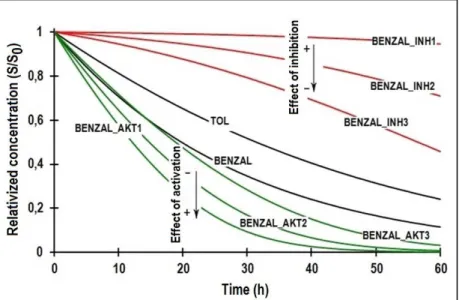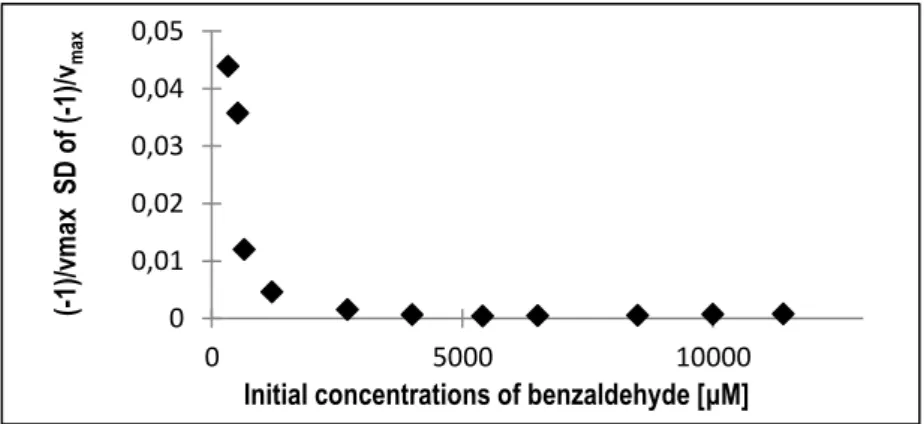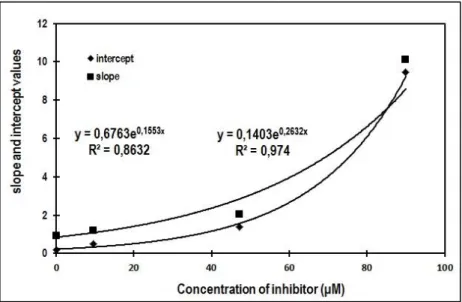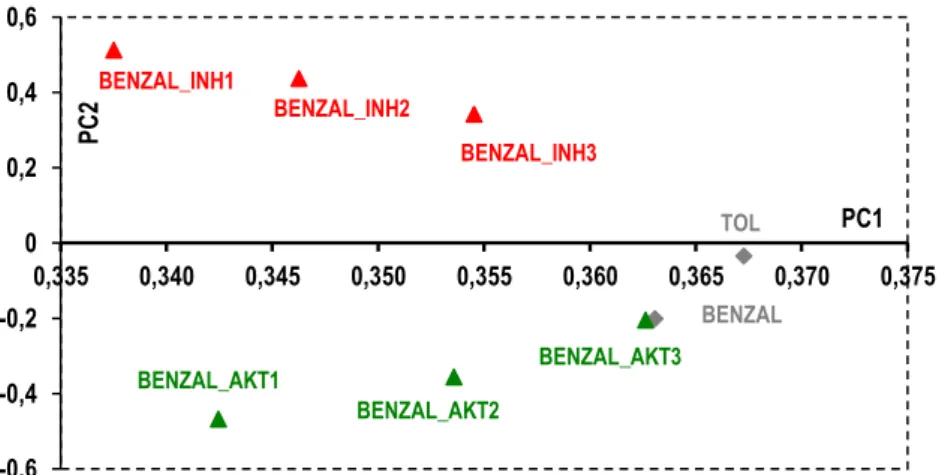University of West Hungary
Theses of PhD dissertation
Investigation of biocatalytic processes in the environmental strategy
Zoltán Herke
Sopron
2015
University of West Hungary Faculty of Forestry
Kitaibel Pál Doctoral School of Environmental Science
Chief:
Prof. Dr. Márton Veress DSc.
Bioenvironmental Science Program Program leader: Prof. Dr. Levente Albert
Supervisors:
Dr. Zsolt István Németh
Dr. Tibor Cserny
1
Introduction
Bioremediation technologies have been used widespread in the biotechnological field of environmental applications during the preceding decades, which are based on the degradation of contaminants by enzymes from the microorganisms. The bio- catalytic or bioremediation technologies have several ad- vantages over the other physical or chemical ways of rehabili- tation, e.g. relative cost-effectiveness; using them in situ causes less damage to the original function of land and they can be well connected with other environmental processes, respective- ly.
However, it should be said that the applicability of these mi- crobial operations are limited by numerous factors, e.g. they are time-consuming and sensitive to environmental conditions.
The most important factor from the point of view of my re- search work is their dependency from peculiarities of the con- taminated media and contaminants.
An effective execution and optimization of the biocatalytic environmental strategies requires clear understanding of the biochemical degradation processes.
The aim of my doctoral thesis was therefore to investigate
the detection of substrate inhibition and activation effects that
are capable of influencing the rate of enzymatic degradation
using model and experimental data series.
2
Calculation- and experimental methods Modelling of biodegradation
The biodegradation reactions are described by the Michae- lis‒Menten equation:
𝑑[𝑆]
𝑑𝑡 = (−𝑑[𝑃]𝑑𝑡 ) = −𝑣𝑚𝑎𝑥∙𝐾 [𝑆]
𝑀+[𝑆] , (1)
where S – the concentration of model contaminant, as initial substrate (in mmol/L), P – the concentration of product, K
M– the Michaelis-constant of the biodegradation step, v
max– the maximal reaction rate of the biochemical reaction. The results of the model biocatalytic degradation curve are depicted in Fig.
1. These kinetic results are involved the feasible mechanisms of various reversible inhibitions and enzyme activation during demolition of the model substrates. Different solutions of deg- radation model have also been generated by Scilab algorithms.
A realistic noise (with different amplitude of concentration
mean) was superposed to the data series of the substrates.
3
Figure 1. Relativized kinetic curves of model pollutants as a function of time. BENZAL and TOL stand for benzaldehyde and toluene, respectively.
The kinetic curves were calculated without inhibition. BENZAL_INH1-2-3 show inhibition effects of varying strength due to the interaction with tolu- ene. BENZAL_AKT1-2-3 show activation effects of varying strength due to the interaction with K+ ion.
Estimation of the kinetic parameters by regression models The relation (1) is a first order difference equation, which is transformable at the t = 0, S = S
0initial value to the following (1.1) implicit equation:
𝐾𝑀∙ 𝑙𝑛 [𝑆]
[𝑆0]+ 𝑆 − 𝑆0 = 𝑣𝑚𝑎𝑥∙ 𝑡 ,
(1.1)
On the basis of the (1) and (1.1) equation, the values of ki-
netic parameters (K
Mand v
max) can be concluded from the
measuring/model results of the S substrate. After the Lin-
eweaver‒Burk linearization of the (1) equation, the dt/dS and
the 1/S quantities correlate with each other. The K
Mand v
maxkinetic parameters can be estimated from the regression slope
and the intercept of the reciprocal data. In the case of this eval-
4
uation the numerical derivation of the S = S(t) kinetic curves is necessary. According to the S implicit term of equation (1.1) it is transformable into a quasi-multivariate, linear relation. Using the following variables, Y = ln(S/S
0) és X = S we can write this formula:
𝐾𝑀∙ 𝑌 + 𝑋 − 𝑆0 = −𝑣𝑚𝑎𝑥∙ 𝑡 , (1.1.1)
which determines a three-dimensional (Y,X, t) line. The mul- tivariate regression coefficients of the (1.1.1) equation provide opportunity to estimate the kinetic parameters by this alterna- tive method. The estimation accuracy of the two different methods was tested in my research using different extents of noise effect and different initial substrate concentration.
Biocatalytic experiments
Potential environmental pollutants, e.g. benzol, toluene,
benzaldehyde were applied in the biocatalytic experiments,
besides, they were degraded by extracts of earthworm and also
by a specific breakdown product. The biodegradation of pollu-
tants was investigated individually as well as in mixtures ‒ in
case of inhibition effects ‒ and in the presence of KCl or gluta-
tion for the sake of the activation effects. The bioconversions
of the pollutants were quantified using gas chromatography.
5
New scientific results
Thesis 1
The kinetic parameter estimation of the biochemical pro- cesses can be executed more precisely using the elaborated multivariate linear regression method in contradiction to the Lineweaver-Burk double reciprocal plot.
The multivariate linear approach (1.1.1 equation) eliminates the distortion errors of derival calculation and its results so that the extreme big outliers cannot manifest in the database. This method has an additional advantage; it can partly decrease the applied noise effect. On the basis of all this the multivariate linear approach enables to execute more precise estimation.
This interplay is illustrated by Figures 2.a-2.b in case of the prediction -(K
M/v
max) kinetic parameter using the two different estimation methods.
Figure 2.a. Estimation of the -(KM/vmax) parameter and their standard devi- ation renges using the multivariate linear approach with different noise effect
-70 -60 -50 -40 -30 -20 -10 0
0 1 2 3 4 5 6 7 8 9 10 11 12 13
Estimated values (Χ) and SD ranges of -KM/vmax Noise effect (%)
Calculated -(KM/vmax) parameter: -11,44809
6
Figure 2.b. Estimation of the -(KM/vmax) parameter and their standard devi- ation ranges using the Lineweaver–Burk approach with different noise effect
Thesis 2
The theoretical error analysis of Δrv (error of reciprocal maximal reaction rate), namely
∆𝒓𝒗 = ∆𝒉𝒕∙𝑲𝑴
𝑺𝟎 + ( 𝑲𝑴
𝑺 ∙ 𝑺𝟎+𝑲𝑴
𝑺𝟎𝟐 + 𝑺
𝑺𝟎) ∙ ∆𝒉𝒔+𝑲𝑴
𝑺𝟎 ∙ 𝐥𝐧 (𝑺
𝑺𝟎) ∙∆𝑲𝒗 𝑲𝒗
was verified using model data also. In case of lower sub-
strate concentration the precision of the estimation depends
on the measuring error of substrate concentration.
7
The dependence of the maximal reaction rate (v
max) estima- tion on the initial substrate concentration is depicted in the Figure 3.
Figure 3. The effect of benzaldehyde initial substrate concentration on the estimation of -1/vmax kinetic parameter standard deviation values. The noise effect is 5%.
This conclusion indicates also one of the weaknesses of the Lineweaver–Burk linearization method, namely that the big- gest measuring errors of the initial reciprocal reaction rate will occur at the smallest substrate concentration, thereby the pa- rameters of fitting straight line will be modified and the estima- tion will become inaccurate.
0 0,01 0,02 0,03 0,04 0,05
0 5000 10000
(-1)/vmax SD of (-1)/vmax
Initial concentrations of benzaldehyde [μM]
8
Thesis 3
Temporal data series of pollutant concentrations that are resulted by similar degradation mechanism (single or mixed) can be linearly correlated to each other. The pa- rameters of fitting regression straight line (slope and inter- cept) are changed significantly by the enzyme modification effect.
According to the alteration of reference regression straight line parameters the inhibition or activation effects can be de- termined. In case of inhibition the slope of straight line is in- creasing and the intercept is decreasing while in case of activa- tion the alteration of the parameters occurs in the opposite di- rection. The alteration of the regression parameters is a meas- ure of the strength of the modification effect (HERKE et al.
2015). Figure 4.a and 4.b illustrate the results in case of model inhibition and experimental data.
Figure 4.a. Correlations between the normalized concentration data of toluene vs. benzaldehyde. Model data without inhibition (SINGLE) and under various intensity of competitive inhibition effects (BENZAL_INH1-3 )
y = 10,1x - 9,46 R² = 0,721 BENZAL_INH1 y = 1,07x - 0,17
R² = 0,983 REFERENCE
y = 2,03x - 1,37 R² = 0,7766 BENZAL_INH2 y = 1,18x - 0,47
R² = 0,8358 BENZAL_INH3 -0,5
-0,3 -0,1 0,1 0,3 0,5 0,7 0,9 1,1
0 0,2 0,4 0,6 0,8 1
Toluen's relativized data series
Benzaldehyd's relativized data series under and without inhibition effect
9
Figure 4.b. Experimental data of independent degradation trials with single substrate degradation (SINGLE) and of experiments with mixed substrates (MIXED) and with activation compound (BENZAL_AKT).
Thesis 4
Using an empirical exponential function between the regres- sion parameters and the concentration of the inhibitor com- pounds makes it possible to originate the strength of the en- zyme activity modification effect.
y = x R² = 1
BENZAL_SINGLE y = 1,40x - 0,39 R² = 0,9987 BENZAL_MIXED y = 0,40x + 0,63
R² = 0,9517 BENZAL_AKT
0,5 0,6 0,7 0,8 0,9 1 1,1
0 0,2 0,4 0,6 0,8 1 1,2
Benzaldehyde's relativized data series without inhibition effect
Benzaldehyde's relativized data series under inhibition, activation effect and without
10
Figure 5. The relationship between the concentrations of the inhibitor compound and the regression parameters, fitting an experimental function
Using this approach further information is available in the field of the exploration of the inhibition effect. Activator- in- stead of inhibitor concentration is also applicable to measure the strength of the activator effect in the same way.
Thesis 5
Application of PCA method provides an alternative way to indicate the enzyme mechanisms. In consequence of this data representation, the most important information about the kinetic curves appearance on the loadings plot of PC1 and PC2 components.
The processing is applicable to visualize the enzyme activity
modification. Using the reference kinetic dataset and its sub-
strate point (without inhibition or activation effect) is always
necessary while it is compared to the position of the other sub-
strate points (HERKE et al. 2015).
11
Figure 6. PCA of model biodegradation data. BENZAL and TOL for kinet- ics without inhibition and BENZAL_INHI1-3 for inhibition of different strength, respectively, BENZAL_AKT1-3 for activation of different strength
TOL BENZAL BENZAL_INH3
BENZAL_INH2 BENZAL_INH1
BENZAL_AKT3 BENZAL_AKT2
BENZAL_AKT1
-0,6 -0,4 -0,2 0 0,2 0,4 0,6
0,335 0,340 0,345 0,350 0,355 0,360 0,365 0,370 0,375
PC2
PC1
12
Related publications of Zoltán Herke Journal article
HERKE, Z., MASKOW, T., NÉMETH ZS.I.(2015): New method for detection of cross inhibition effects in the environmental biocatalytic processes. BioTechnologia (A kézirat benyújtásra került: 2015. 07.
12.)
Conference proceeding / Abstract book
HERKE Z.,CSERNY T.,MAGYAR B.,NÉMETH ZS.I.(2014):Inhibíci- ós és aktiválási mechanizmusok érzékelési lehetőségei biokatalitikus kármentesítésének alkalmazása során. /Opportunities for indication of inhibition and activation mechanisms in the course of application biocatalytic environmental technologies
/
IN: Bidló A., Horváth A., Szűcs P. (szerk.) (2014): Nyugat-magyarországi Egyetem, Erdőmér- nöki Kar, IV. Kari Tudományos Konferencia. NymE Erdőmérnöki Kar, Sopron pp. 95-99.Z.HERKE, T. CSERNY,B.MAGYAR,ZS.I.NÉMETH (2014): Explora- tion of enzyme activity change based on correlation and principal component analysis IN:L.ALBERT,P.SZABÓ (editors):Kémia, Kör- nyezettudomány, Fenntarthatóság pp. 23-29.
HERKE Z., CSERNY T., MAGYAR B., NÉMETH ZS. I. (2013):
Enzimkatalitikus mechanizmusok indikálási lehetőségei bioremediációs kármentesítések alkalmazása során, /Opportunities for indication of the enzyme catalytic mechanisms in the course of application the bioremediation technologies/
,
Környezetvédelmi Analitikai és Technológiai Konferencia, Absztrakt könyv, Hajdúszo- boszló, 2013. október 2-4.Z. HERKE, T. CSERNY,B.MAGYAR,ZS.I.NÉMETH (2013): Evalua- tion of enzyme kinetic data based on correlation and principal com- ponent analysis, Conferentia Chemometrica, Abstract book, Sopron, pp. 203.
Z. HERKE, T. CSERNY,B.MAGYAR,ZS.I.NÉMETH (2012):Explora- tion of enzymatic degradations by chemometric methods, IN: K.
HÉBERGER & T. L. PAP (editors): XIIIth Conference on Chemo- metrics in Analytical Chemistry, Programme & Book of Abstracts Budapest 25-29. June 2012.
13
Z. HERKE, T. CSERNY, B. MAGYAR, ZS. I. NÉMETH (2012):
:Indication of Biocatalytic Mechanisms in Environmental Remedia- tion by Statistical Methods, IN: M. NEMÉNYI, B. HEIL, A. J. KO- VÁCS, F. FACSKÓ (editors): International Scientific Conference on Sustainable Development & Ecological Footprint, Sopron, Universi- ty of West Hungary Press.
HERKE Z.,CSERNY T.,MAGYAR B.,NÉMETH ZS.I. (2011): Inhibíci- ós mechanizmusok indikálása szennyező komponensek enzim kine- tikai adatsorainak korreláltatásával, /Rectification of inhibition mechanisms by correlation of pollutant compounds data series/ IN:
LAKATOS F. és SZABÓ Z. (szerk.): Nyugat-magyarországi Egye- tem, Erdőmérnöki Kar, Kari Tudományos Konferencia Kiadvány Nyme Kiadó Sopron.
Z.HERKE,T. CSERNY,B.MAGYAR,ZS.I.NÉMETH (2011): Detec- tion of enzyme inhibition by regression analysis of kinetic curves, Conferentia Chemometrica, Abstract book, Sümeg.
HERKE Z., NÉMETH ZS. I (2011): Inhibíciós hatások kimutatása komplex enzim rendszerekben statisztikai módszerekkel, /Indication of inhibition effects in complex enzyme systems by statistical methods/ Lakatos F., Polgár A., Kerényi-Nagy V. (szerk.): Tudomá- nyos Doktorandusz Konferencia, Konferencia-kötet, Nyugat- magyarországi Egyetem Erdőmérnöki Kar, NymE Kiadó.
Conference and symposium presentation
Z.HERKE,T.MASKOW,ZS.I.NÉMETH:An alternative approach to detect the inhibition effects ont he environmental biocatalytic pro- cesses. 1ST International Symposiumfor Students and PhD Students
„Environmental Biotechnology” 21-22. 05. 2015, Gliwice, Poland.
HERKE Z.,CSERNY T.,MAGYAR B.,NÉMETH ZS.I.:
Inhibíciós és aktiválási mechanizmusok érzékelési lehetőségei kör- nyezetszennyező anyagok biodegradációs vizsgálatakor, /Opportunities for indication of the enzyme catalytic mechanism by investigation of environment pollutants biodegradation/ KeMoMo- QSAR 2014, 2014. május 22-23., Szeged
HERKE Z., CSERNY T.,MAGYAR B.,NÉMETH ZS.I.: Inhibíciós és aktiválási mechanizmusok érzékelési lehetőségei biokatalitikus kár-
14
mentesítésének alkalmazása során, /Opportunities for indication of inhibition and activation mechanisms in the course of application biocatalytic environmental technologies
/
Kari Tudományos Konfe- rencia, NymE-EMK, Sopron, 2013. december 10.HERKE Z., CSERNY T., MAGYAR B., NÉMETH ZS. I.:
Enzimkatalitikus mechanizmusok indikálási lehetőségei bioremediációs kármentesítések alkalmazása során, /Opportunities for indication of the enzyme catalytic mechanisms in the course of application the bioremediation technologies/ Környezetvédelmi Ana- litikai és Technológiai Konferencia, Hajdúszoboszló, 2013. október 2-4. (Poster)
Z. HERKE, T. CSERNY, B.MAGYAR,ZS.I. NÉMETH: Evaluation of enzyme kinetic data based on correlation and principal component analysis, Conferentia Chemometrica, Abstract book, Sopron, 8-11.
September 2013. (Poster)
HERKE Z.,CSERNY T.,MAGYAR B.,NÉMETH ZS.I.:Enzim kinetikai adatsorok feldolgozása korrelációs és főkomponens elemzési mód- szerekkel, /Exploration of enzyme activity change based on correla- tion and principal component analysis/Nyugat-magyarországi Egye- tem, Erdőmérnöki Kar, Kémiai Intézet, Sopron, 2013. augusztus 29.
HERKE Z.,CSERNY T.,MAGYAR B.,NÉMETH ZS.I.: Enzim kinetikai adatsorok feldolgozása korrelációs és főkomponens elemzési mód- szerekkel. /Analysing of the enzyme kinetic data series by correlation and principal component analysis/ KeMoMo-QSAR 2013, 2013.
április 29-30., Szeged
HERKE Z., CSERNY T., MAGYAR B., NÉMETH ZS. I.: Statisztikai módszerek alkalmazása enzim mechanizmusok indikálására, /Application of statistical methods to indication of enzyme mecha- nisms/ VIII. Regionális Természettudományi Konferencia, Szombat- hely, 2013. január 24.
HERKE Z.,CSERNY T.,MAGYAR B.,NÉMETH ZS.I.: Exploration of enzymatic degradations by chemometric methods, XIIIth Conference on Chemometrics in Analytical Chemistry, Budapest 25-29. June 2012. (Poster)
15
HERKE Z., CSERNY T.,MAGYAR B., NÉMETH ZS. I.: Indication of Biocatalytic Mechanisms in Environmental Remediation by Statisti- cal Methods, International Scientific Conference on Sustainable De- velopment & Ecological Footprint, Sopron 26-27. March 2012.
(Poster)
HERKE Z.,CSERNY T.,MAGYAR B.,NÉMETH ZS.I.: Inhibíciós mec- hanizmusok indikálása szennyező komponensek enzim kinetikai adatsorainak korreláltatásával, /Rectification of inhibition mecha- nisms by correlation of pollutant compounds data series/ Nyugat- magyarországi Egyetem, Erdőmérnöki Kar, Kari Tudományos Kon- ferencia, Sopron 2011. október 5.
HERKE Z., CSERNY T., MAGYAR B., NÉMETH ZS. I.: Detection of enzyme inhibition by regression analysis of kinetic curves, Conferen- tia Chemometrica, Sümeg 18-21. September 2011. (Poster)
HERKE Z., NÉMETH ZS. I.: Inhibíciós hatások kimutatása komplex enzim rendszerekben statisztikai módszerekkel, /Indication of inhibi- tion effects in complex enzyme systems by statistical methods/ Tu- dományos Doktorandusz Konferencia, Sopron, 2011. április 13.
Other publications of Zoltán Herke Conference proceeding / Abstract book
Zs. I. NÉMETH, R. RÁKOSA, Z. HERKE: Revealing Factor Effects on NIR Spectra of Alcohol-water Mixtures by Principal Component Analysis. Conferentia Cemometrica, Abstract book
MÉSZÁROS I., OLÁH V., VERES SZ., LAKATOS Á., RASZTOVITS E., HERKE Z.(2010):Analysis of ecophysiological plasticity of Europe- an beech provenances in the Hungarian provenance trial. In: Book of Abstracts. COST E52 "Evaluation of beech genetic resources for sustainable forestry" Final Meeting, Burgos, Spain, 4-7 May 2010.
Z. HERKE (2015): Untersuchung biokatalytischer Produkte zum Fremdstoffabbau, /Investigation of biocatalytic products for degrada- tion of environment pollutants/ DBU-ösztöndíj záró kutatási beszá- moló
Conference and symposium presentation
Zs. I. NÉMETH, R. RÁKOSA, Z. HERKE: Revealing Factor Effects on NIR Spectra of Alcohol-water Mixtures by Principal Component
16
Analysis. Conferentia Cemometrica, 2015. szeptember 13-16., Bu- dapest
SÁRAINÉ RAUCH R., HERKE Z.: Talajszennyező szénhidrogének bontása biokatalitikus technológiával, /Degradation of soil contaminants by biocatalatic technology/ „Kármentesítés aktuális kérdései szimpózium 2013”, Budapest, 2013. március 21-22.







